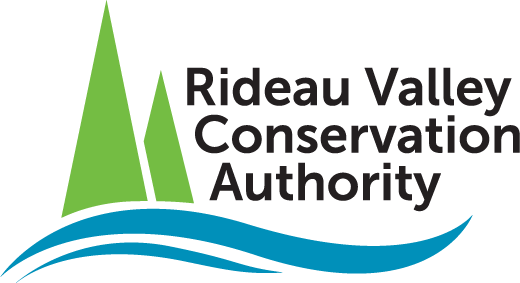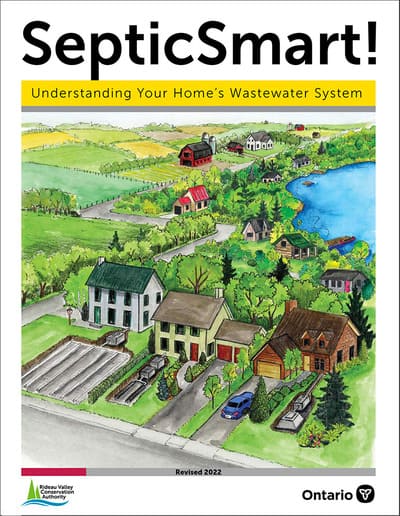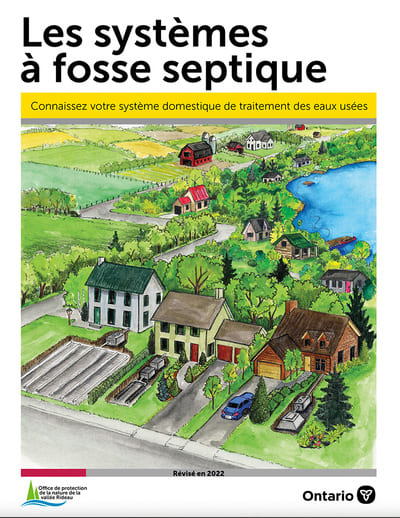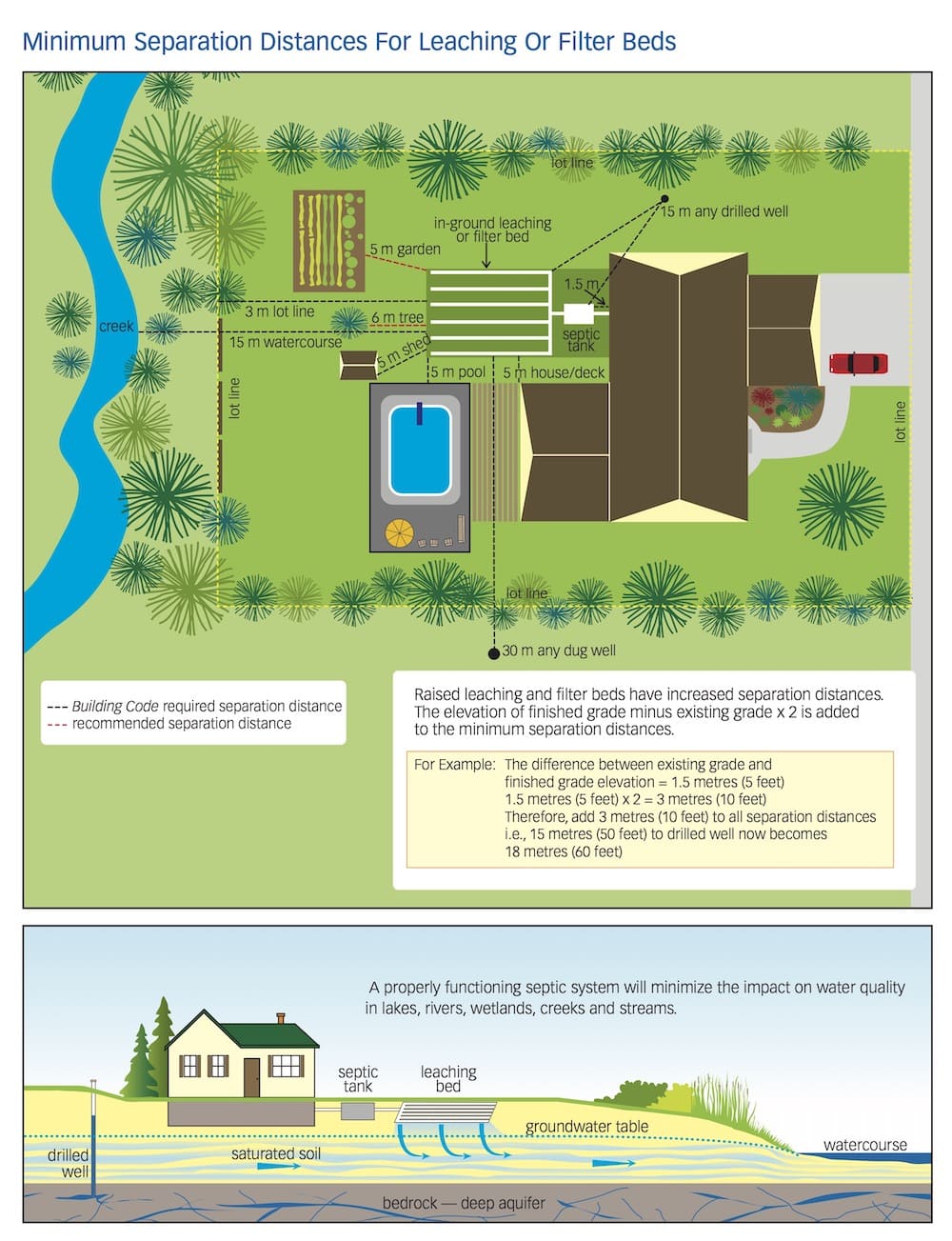Frequently Asked Questions
Your local conservation authority may have an agreement with your municipality to administer Part 8 of the Ontario Building Code, which focuses on septic system approvals. This applies to the design, construction, operation, and maintenance of all sewage systems and the construction of buildings in the vicinity of the sewage system. Our role is to enforce Ontario Building Code regarding onsite sewage systems and associated bylaws and Provincial regulations as they relate to sewage systems under the Code.
Sewage system means,
- chemical toilet, an incinerating toilet, a recirculating toilet, a self-contained portable toilet and all forms of privy, including a portable privy, an earth pit privy, a pail privy, a privy vault and a composting toilet system,
- a greywater system,
- a cesspool,
- a leaching bed system, or
- a system that requires or uses a holding tank for the retention of hauled sewage at the site where it is produced before its collection by a hauled sewage system,
where these,
- have a design capacity of 10,000 litres per day or less,
- have, in total, a design capacity of 10,000 litres per day or less, where more than one of these are located on a lot or parcel of land, and
- are located wholly within the boundaries of the lot or parcel of land on which is located the building or buildings they serve.
- Property Owner: When they are the owner of the property, and they may submit a design for the installation of their own onsite sewage system.
- Licensed Installers: When the installer has registered their BCIN with the MMAH as a Supervisor and Installation Firm for On-site Sewage Systems, they may submit designs for work that only they will be completing.
- Qualified Designers: When a person has registered their BCIN with the MMAH as a Qualified Designer, they may submit applications for designs that may be installed by the Property Owner or Licensed Installer.
Find a licensed installer or qualified designer through the Ontario On-Site Wastewater Association's directory.
During the design phase of your septic system replacement/new construction project, the following topics are generally covered:
- Site visit to verify lot features like lot lines, current well placement, inventory current dwelling for number of bedrooms/plumbing fixtures/finished floor area
- Tank and bed sizing to accommodate size of dwelling
- Best placement of system on lot respecting restricted distances to any lot features
- Elevations of lot, soil and water table conditions This information is required to adequately complete the Application for Demolition/Construction. It is strongly recommended that the licensed installer/designer submit the application on behalf of the property owner. If the property owner engages in this design service, a letter of authorization/agency is required to release any approved applications to an individual other than the property owner.
- Constructing a new home or building that will be serviced by an onsite sewage system not by municipal sewers will require a Septic Permit.
- Replacing an existing sewage system that has reached the end of serviceable life will require a Septic Permit.
- Altering or repairing any part of a sewage system will require a Septic Permit. A property owner may pump-out and clean their septic tank, the manufacturer may conduct annual service on a treatment unit, but all other work on a septic system will require a permit.
- Renovations to an existing home adding fixture units, adding bedrooms, or increasing the finished floor area by more than 15 percent of the current footprint will require an Approval. Adding a secondary dwelling to an existing dwelling will require Approval.
- Changing the use of an existing structure to or from Residential to Commercial, or from one type of commercial to another will require Approval.
- Demolishing an existing septic system as part of the demolition of the associated dwelling, or when the building is being connected to municipal sewers a Decommissioning Certificate is required.
For new/replacement systems — obtain copy of Application for Demolition/Construction application (11 pages in total), suggest consulting a licensed installer or qualified designer to determine the septic system design. This completed application is to be submitted directly to our offices:
- Application requirements: Three (3) copies if submitting paper copies. Electronic submissions are prefered.
- Fee: Payment at time of submission (Fees for residential applications are on our Fee Schedule).
- Supporting documents:
- copy of site survey,
- tax bill,
- agreement to purchase or Title and Deed indicating property ownership/ legal and
- civic address description of property in question.
- Response Time: The Building Code directs that these be reviewed within a 10 day window, however our offices endeavour to respond within fiver business days — pending submission of all related documents/drawings/information as requested by the area inspector
- Of note, new housing construction — septic applications are required to be approved prior to building application submission directly to the municipal building department.
- Copy of a service report by a manufacturer trained service provider within the last
6 months, or - Proof of manufacturer training by your selected service provider, if requested by this
office, or - Contact your service provider to renew/renegotiate a service contract. A copy of the renewed service agreement must then be submitted to the conservation authority on or before the existing contract’s expiry date, and
- a. Contract must be signed by both parties, that being the current property owner on title and the de signate from the service provider, and
- b. Service provider must indicate on renewed contract that client’s account is in good standing order, which means that it is clear of any service suspensions
- If change of property owner occurs, current property owner must disclose to prospective purchaser existing treatment unit contract and advise service provider of impending sale and name of new owner.
Maintaining Your Septic System
Check out our latest edition of Septic Smart, the homeowner’s handy guide to maintaining a healthy septic system:





